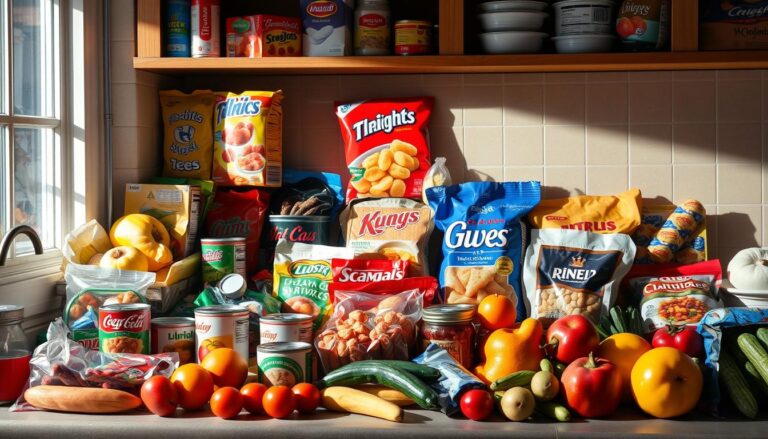Tired of diets that promise a lot but don’t deliver? The key to losing weight and keeping it off may be easier to find than you think.
Let’s dive into diet and weight loss methods that can truly change your life for the better.
The first source tells us that real weight loss needs lasting lifestyle changes. A mix of healthy eating and more exercise is crucial. Next the top priority in managing your weight effectively must be to stop extra fat. This approach starts in the military from the very first day.
Soldiers learn how to avoid gaining too much weight and keep a healthy body. The third source stresses that living healthily and controlling your weight go hand-in-hand. Quick diets don’t work in the long run. The key to losing weight safely and keeping it off means slowly changing your lifestyle for the better.
Key Takeaways
- Sustainable weight loss requires a combination of a healthy, calorie-controlled diet and regular physical activity.
- Preventing unwanted weight gain is crucial, especially in the military, where a proactive approach from the start can set individuals up for long-term success.
- Crash diets are not the answer – gradual, permanent lifestyle changes are the key to safe, lasting weight management.
- A balanced, nutrient-dense diet and an active lifestyle are essential for healthful living and better weight control.
- Monitoring your progress and adjusting your approach as needed are critical for maintaining weight loss over the long term.
Prepare for Lasting Change
Starting a weight loss journey is a big step that needs commitment. You need to be ready and motivated to adjust your lifestyle. Remember, getting to a healthy weight takes time and effort. It’s critical to keep a positive attitude and have supportive people around you.
Assess Your Readiness
First, you need to look at how ready you are for a change. Ask yourself, Do I want to lose weight? and Can I handle stress in different ways? Also, think about changing how you eat and what activities you do. Be honest with your answers. They’ll show if you’re prepared for the work that goes into losing weight safely.
Find Intrinsic Motivation
Losing weight is more than just numbers on a scale. It’s about choosing a healthier life every day. Figure out why you want to lose weight deep down. This could be to have more energy, prevent illnesses, or feel better about yourself. When your reasons are personal, it’s easier to stick to your plan.
Build a Support System
Going on a weight loss journey alone is hard. It’s important to have people who cheer you on. This could be friends, family, a dietitian, or a trainer. Joining a group that helps with weight loss can also be very beneficial. They provide encouragement and can make achieving your goals easier.

Set Realistic Goals
Diet and weight loss are made better by setting real goals. A top way is to lose between 1 to 2 pounds each week. This means cutting 500 to 1,000 calories daily. This method is great because it encourages healthy eating habits and doing workouts. It also keeps your body composition and metabolism in good check for a long time.
Aim for Gradual Weight Loss
One smart goal may be a 5-10% cut in your body weight over six months. For many, this means eating between 1,000 to 1,600 calories every day. Losing weight slowly and at a healthy rate of 1-2 pounds each week is safe and works well.
Combine Process and Outcome Goals
Setting outcome goals is good, like how many pounds you aim to lose. But, process goals matter too, such as walking daily for 30 minutes. Doing both increases your chance of keeping the weight off by changing your lifestyle. Using apps and keeping a food journal can make it easier. Regular talks with a health expert can keep you on track as well.

Embrace Healthier Eating Habits
Sticking to a healthy diet is key to losing weight and getting fit. A plant-based diet is a smart choice. It lets you lose weight and gives your body all it needs like vitamins and minerals. Eating a mix of fruits, vegetables, whole grains, lean proteins, and healthy fats fights off junk food desires. It also helps balance your calories and changes in your body.
Increase Plant Based Foods
Eat plenty of plant-based foods – think leafy greens, colorful fruits and veggies, beans, and whole grains. These foods are rich in nutrients and low in calories. Plus, they have lots of fiber. Eating this way helps you feel full and improves your digestion. It also helps step up your metabolism and makes losing weight easier.
Choose Nutrient-Dense Options
When you plan meals, pick foods that are full of good stuff like vitamins and minerals. Go for fresh fruits and vegetables, lean proteins, whole grains, nuts, and seeds. These foods are packed with nutrients. They make you healthy, and ready for workouts and fun activities.
Limit Refined Carbs and Added Sugars
Reducing refined carbs and sugars can help a lot with weight loss and health. Refined carbs and sugars make your blood sugar jump. This can lead to wanting more sweets and more weight. Instead, eat complex carbs found in whole grains, legumes, and high-fiber fruits and vegetables. They give you a steady energy and keep your metabolism working well.

Incorporate Regular Physical Activity
Getting to a healthy weight involves many steps, and being active regularly is key. Exercise helps burn those extra calories that just dieting can’t. Try to walk briskly for 30 minutes most days and move more throughout the day. This will really help you lose weight and make your metabolism work better.
Start Slowly and Increase Gradually
If you’re not used to moving much, start slowly. The second source suggests easing into 30 minutes of daily activity. This builds a sustainable exercise routine and prevents getting tired too quickly. Starting slow leads to a lasting active lifestyle, increasing your chances of sticking with it.
Combine Aerobic and Strength Training
To make your weight loss better, mix aerobic exercise with strength training. This approach, as the second source highlights, can be more effective long term. Doing both cardio and weightlifting helps boost your metabolism, keep your lean muscle, and change your body composition. It’s a great way to reach your weight goals.

Diet and Weight Loss Strategies
Want to lose weight and keep it off? Start with a plan for your diet and how you live. You’ll need to eat fewer calories and watch what you eat. And tracking your nutrition helps a lot too. This combo can lead to a leaner, healthier you.
Calorie Deficit for Weight Loss
To lose weight, you first need to cut back on calories. By aiming to eat 500 to 1,000 calories less each day, you might shed 1 to 2 pounds weekly. It’s also key to gradually reduce your body weight by 5-10% over six months. This should include cutting down to 1,000-1,600 calories daily.
Portion Control and Mindful Eating
It’s not just about eating less how much matters too. Keeping portions in check and being mindful of what you eat are crucial. Understanding your body’s signals for hunger and fullness can build a better food relationship. This makes losing weight easier to manage over time.
Nutrition Tracking and Food Journaling
Tracking what you eat is a smart move for losing weight. It lets you see your daily calorie and nutrient intake. This info helps you make choices that support your weight loss. The more you know about your eating habits, the better you can tailor your diet.

Lifestyle Modifications for Success
To lose weight for good, you have to do more than change your diet. It’s about making changes in your life that will help you stay healthy. Start by looking at your daily habits and figure out what might be stopping you from losing weight.
Environmental Control
Changing the way your home and work areas look can help you lose weight. Clear out your kitchen. Fill it with healthy foods and get rid of unhealthy snacks. Also, organize your fridge and pantry to help with eating the right portions.
Create a space at home where you can work out. Or find exercises that you can do every day.
Stimulus and Cue Management
Notice the things around you that make you want to eat unhealthy foods. These could be anything from what you see to who you’re with. Once you know what they are, try to stay away from them. For example, skip certain parts of the store, eat without the TV, or do your food tracking away from distractions.
By changing your surroundings and how you respond to food and activity triggers, you can start on the path to long-lasting weight and healthy lifestyle.

The Role of Exercise in Weight Loss
Adding physical activity to your weight-loss journey is key for success. It’s best to combine regular exercise with a diet that limits calories. Doing so helps boost your metabolism and keeps your muscles healthy.
Boost Metabolism and Preserve Muscle Mass
Strength training and aerobics, when done together, are better for losing weight than just aerobics. Strength training keeps your muscles strong and helps keep your metabolism from slowing down. This means you burn more calories even when you’re not working out, which aids in burning fat.
Combine Exercise with Calorie Restriction
Studies show exercising and eating fewer calories together help in losing weight best. For example, the Midwest Exercise Trial 2 proved that just doing aerobics helps in losing weight. The Willis et al. study found that adding strength training to your routine can help reduce your overall weight and fat.
So, a balanced plan including both exercise and healthy eating is the way to go. It helps you manage your weight over time and builds a fitter, healthier you.
Overcoming Challenges and Setbacks
Starting a weight loss journey shows how determined you are. Yet, it’s filled with hurdles. You might lack motivation or set goals that are too high. Emotional eating, stubborn plateaus, and these setbacks are common. But, understanding these challenges and finding ways to beat them can lead you to lasting success.
Identify Barriers and Develop Strategies
First, know what’s stopping you from losing weight. You might eat more when you’re stressed or find it tough to say no to friends. Feeling impatient with slow progress is also common. Shedding light on your challenges helps find solutions. Then, you can tackle them with specific plans.
Celebrate Small Victories
On your journey, stopping to appreciate small wins is vital. Maybe you fit back into old jeans or lost some pounds. These little victories signal progress. They boost your motivation and build your confidence. Recognizing these wins, even if small, is key to facing tougher times.
Stay Positive and Persistent
Remember, losing weight takes time and steady effort. Some days, you might struggle more, needing to reset your goals. But staying focused and positive is crucial. Don’t give up and keep moving forward. With patience and a positive learning attitude, a healthier future is within reach.
Maintaining Weight Loss Long-Term
Keeping the weight off long-term is about more than just losing weight. It’s about making changes for life that keep you on track with your diet and weight loss goals. Once you’ve been dieting for about 6 months, you might notice that losing weight slows down.
This can be tough and lead to weight cycling if you’re not careful. The secret is making a sustainable lifestyle full of healthy eating habits and regular physical activity.
Adopt a Sustainable Lifestyle
Studies tell us that mixing diet-plus-exercise works better for long-term weight loss than just focusing on diet. You can use a calorie deficit keep track of what you eat and stick to a exercise plan to transform not only your weight but your health. Remember, the aim is to keep these changes for good, rather than looking for quick fixes or fad diets.
Continued Monitoring and Adjustments
To stay successful, you must keep an eye on your diet and exercise. Watching your portion control, macro counting, and intermittent fasting is key. You should also be ready to adjust your calorie counting and healthy eating strategies.
Regularly checking in and reviewing your body composition can help you see where you can do better. This way, you can make sure your metabolism boosters, fat burning plans, and clean eating habits keep on working for keeping weight off.
Conclusion
In the mission to stay at a healthy weight, the key is a full lifestyle change. This includes good food, exercise, and smart weight plans. This mix helps people find a way to be slimmer and healthier.
Many studies have shown us how to keep off weight in the long run. They talk about changing our habits and how our bodies work. It shows us how to keep trying and never give up on staying healthy and fit.
To be healthier and full of life, you need to keep at it and be open to new ideas. Making small but lasting changes every day is the way forward. Eat well, move more, and think about your body as a whole. Those who do see real changes and enjoy a new way of life.





